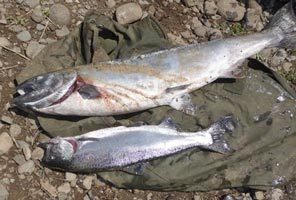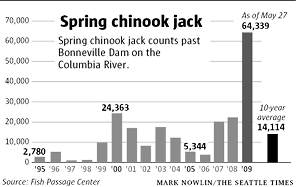forum
library
tutorial
contact

Spring Chinook Jack Count Confounds Biologists
by Allen ThomasThe Columbian, June 3, 2009
|
the film forum library tutorial contact |

|
Spring Chinook Jack Count Confounds Biologists
by Allen ThomasThe Columbian, June 3, 2009 |
 Northwest fish managers and scientists have been watching the daily Bonneville Dam counts with amazement, and asking this question: Why are spring chinook jacks streaming up the Columbia River in record-busting numbers?
Northwest fish managers and scientists have been watching the daily Bonneville Dam counts with amazement, and asking this question: Why are spring chinook jacks streaming up the Columbia River in record-busting numbers?
Jacks are 3-year-old spring chinook salmon, fish that return to spawn a year earlier than their siblings. Four-year-olds make up the bulk of the spring chinook run annually in the middle and upper Columbia and Snake rivers.
Through Tuesday, the jack count at Bonneville Dam totaled 68,371, on its way to being about 80,000 before counting ends of June 15. The old record was 24,363 in 2000.
Using the historical relationship between jacks and 4-year-olds, next year's spring chinook run would be the range of 1.2 million to 1.5 million.
And no one expects that, particularly given the fact that Columbia River Technical Advisory Committee, composed of state, tribal and federal biologists, has hugely overpredicted the spring chinook for the past two years.
This year's forecast of 298,900 will end up in the range of 160,000.
"What does it mean? Who knows?" said Cindy LeFleur, Columbia River policy coordinator for the Washington Department of Fish and Wildlife. "The jacks, and the performance of the adult returns, are so far off the charts, we just don't know yet."
Stuart Ellis of the Columbia River Inter-Tribal Fish Commission and chairman of the Technical Advisory Committee, echoed LeFleur.
"It's a fascinating mystery right now," Ellis said.
Lots of fishery biologists and others are going to be studying a plethora of data between now and December, when the 2010 spring chinook forecast will be completed.
Size of this year's jacks, the hatchery-wild ratio, which sub-basins they are headed for and more all will be studied, LeFleur said. Fishery biologists also will meet with federal ocean scientists to look for correlations with ocean conditions and the huge jack count.
"There's just a whole bunch of interest in this topic," she said.
Ellis said it appears from sampling at Bonneville Dam that the jacks are 3-year-olds and not stubby 4-year-olds, and that they are destined for most or all of the sub-basins.
 The jack rate does appear higher for hatchery fish than wild chinook, he said.
The jack rate does appear higher for hatchery fish than wild chinook, he said.
Ellis said individuals will formulate a theory, but then find a cause to refute it.
For example, maybe the jacks are leaving the ocean early because they judge the survival conditions to be poor and it's better to try to spawn a year early. Except, he said, ocean conditions are reported to be excellent this year.
"We think through these things and then find a reason why they don't quite fit the puzzle," Ellis said.
This year's jacks would forecast about 1.4 million 4-year-old chinook next year, he said.
"We know that's not very realistic. One thing this will require is us revising how we look at the forecast and making adjustments in the methodology."
learn more on topics covered in the film
see the video
read the script
learn the songs
discussion forum
